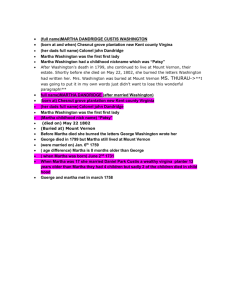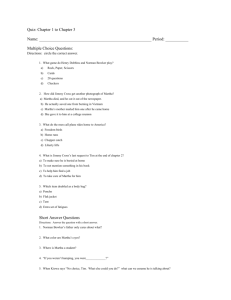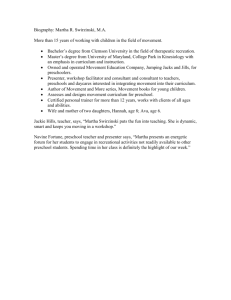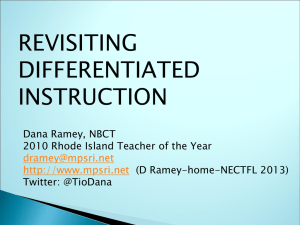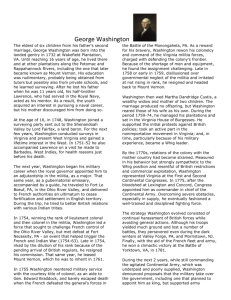www.tonyrogers.com/humor/ american_presidents.htm www
advertisement
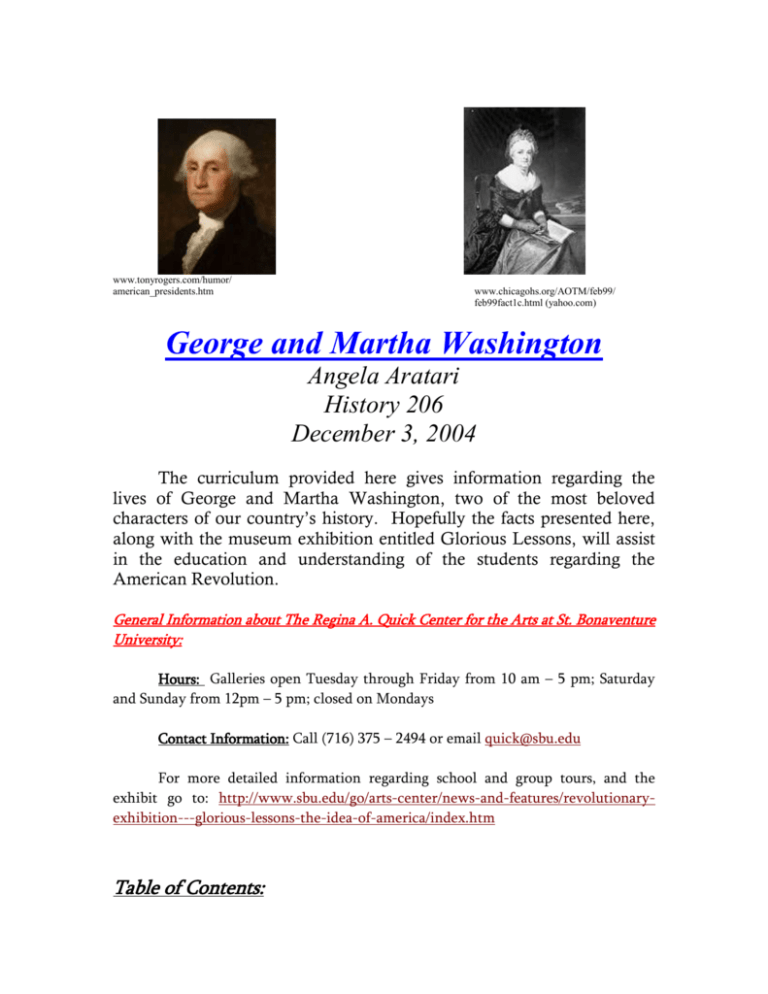
www.tonyrogers.com/humor/
american_presidents.htm
www.chicagohs.org/AOTM/feb99/
feb99fact1c.html (yahoo.com)
George and Martha Washington
Angela Aratari
History 206
December 3, 2004
The curriculum provided here gives information regarding the
lives of George and Martha Washington, two of the most beloved
characters of our country’s history. Hopefully the facts presented here,
along with the museum exhibition entitled Glorious Lessons, will assist
in the education and understanding of the students regarding the
American Revolution.
General Information about The Regina A. Quick Center for the Arts at St. Bonaventure
University:
Hours: Galleries open Tuesday through Friday from 10 am – 5 pm; Saturday
and Sunday from 12pm – 5 pm; closed on Mondays
Contact Information: Call (716) 375 – 2494 or email quick@sbu.edu
For more detailed information regarding school and group tours, and the
exhibit go to: http://www.sbu.edu/go/arts-center/news-and-features/revolutionaryexhibition---glorious-lessons-the-idea-of-america/index.htm
Table of Contents:
I.
II.
III.
IV.
V.
VI.
VII.
Life of George Washington
Life of Martha Dandridge Custis Washington
Use of Glorious Lessons: The Idea of America
Social Studies Standards and Useful Websites
Ideas for Lesson Plans
Fun Facts About George Washington
Bibliography
I. Life of George Washington:
“As the first of everything, in our situation will serve to establish a
Precedent, it is devoutly wished on my part, that these precedents may be
fixed on true principles.”
- From a letter written to James Madison
www.sd4history.com/unit1/
washington.htm (yahoo.com)
1732 – Born February 22 in Westmoreland Co., Virginia into a planting family
Had little schooling, but growing up he took an interest in geography,
surveying, mathematics and military history
1749 – Appointed official surveyor for Culpeper Co. in which he made surveys for
landowners on the Virginia frontier
1758 – Elected to the House of Burgesses and served for 17 years
1759 – Married Martha Dandridge Custis on January 6
from this time until the start of the war he managed his lands and served
in the HOB although he began to voice his resistance to increased British
restrictions
1774/1775 – Elected as Virginia delegate to the First and Second Continental
Congress; Congress named him commander of the Continental Army after
fighting broke out between Massachusetts and the British
1776 – Dec. 25 crossed the icy Delaware River to capture Trenton in a surprise
attack
1777 – Jan. 3 defeated British troops at Princeton
both of these victories restored patriot morale and helped to increase the
number of recruits
1781 – With the aid of French allies he forced the surrender of General
Cornwallis at Yorktown
1783 – Returned to Mount Vernon to pursue his agricultural interests
1787 - Soon realized that the nation under its Articles of Confederation was not
functioning well
Elected a delegate and then president of the Constitutional Convention
which stressed the importance of a stronger central government
1788 – After Constitution was ratified Electoral College unanimously elected him
President (again in 1792)
1788-1797 – During his administration he appointed Thomas Jefferson as
Secretary of State (pro-French) and Alexander Hamilton as Secretary of the
Treasury (pro-British)
o Issue of foreign policy a main concern and recommended a policy of
neutrality
o After viewing the development of 2 political parties, he prepared his
Farewell Address which warned citizens against long-term alliances, and
political factions
1799 – Dec. 14 died of a throat infection after only 3 years of retirement at Mount
Vernon
II. Life of Martha Dandridge Custis Washington:
“I am still determined to be cheerful and happy, in whatever situation I may
be; for I have also learned from experience that the greater part of our
happiness or misery depends upon our dispositions, and not upon our
circumstances.”
-written to her friend Mercy Otis Warren
1731 – Born June 2 in New Kent County, Virginia on a plantation to John and
Frances Dandridge
o Hardly any education except in domestic and social
skills; learned how to keep a nice household and family
1749 – Married first husband Daniel Park Custis who owned a
large plantation and had four children:
Daniel (1751, died 1754)
Frances (1753, died 1757)
John “Jacky” (1755)
Martha “Patsy” (1756)
1757 – On July 26 her husband died suddenly after a brief illness
1759 – January 6 she married Colonel George Washington and they relocated to
Mt. Vernon with Jacky and Patsy
o Here her main concern was with the comfort and happiness of her family
and caring for their home
o Took great pride in her ability to welcome and be hospitable towards
guests and strangers
1773 – June 19 daughter Patsy dies at Mount Vernon
1774 – Son Jacky marries Eleanor “Nelly” Calvert at their estate
1775 – George elected Commander-in-Chief of the Continental Army
o Martha, along with Jacky and Nelly, spends the winter at his
headquarters in Cambridge, Mass
1781 – Nov. 5 son John Parke Custis dies of “camp fever” (typhoid fever)
o Wife Nelly remarries in 1783 and lives with two eldest daughters while
two younger children (Eleanor Parke Custis and George Washington
Parke Custis) stay at Mount Vernon
1789 – April 30, George inaugurated as President and they live together in
Philadelphia
1797 – On March 15, George, Martha and their grandchildren move back to
Mount Vernon
1799 – December 14 George dies
1802 – Martha dies on May 22 after being a widow for two and one-half years
from a “severe fever”
o Both are entombed next to each other at Mount Vernon
III. Glorious Lessons: The Idea of America
Within this exhibit, there are numerous items which attempt to help the viewer
understand and relate to the lives of the Washington’s. Some of these objects are of
great appeal because they cement the popular idea of George Washington as our
most important social or national icon. On the other hand, many of the articles give
a glimpse into the everyday lives of this Virginia planter and his family within their
Mount Vernon estate. These are only a few of the objects in the exhibition which help
to illustrate how and why our country views the Washington’s in such a glorified
manner.
www.utc.edu/Faculty/Melissa-Anyiwo/
HY203/HY203.htm (yahoo.com)
1.) Exhibit #116: Manuscript orderly book kept at headquarters of General
Washington from July 9 to October 18, 1775.
This orderly book gives the viewer a chance to see how the mythology of George
Washington was formed early on. During the French and Indian War, he
miraculously escaped the Battle of Monongahela and a clergyman commented
that that he was a “heroic youth” and that hopefully he would have “some
important service to his country”. Washington was able to gain valuable military
experience and after was selected to lead the Continental Army.
Washington Crossing the Delaware, 1874
Possibly by Robert Weir (exhibit # 127)
http://www.sbu.edu/go/arts-center/news-and-features/revolutionary-exhibition---glorious-lessons-the-ideaof-america/index.htm
2.) This portrayal of George Washington bravely crossing the icy Delaware River
alongside his troops is probably the most famous painting attempting to depict the
great leadership and drive that he possessed. However, in actuality there are
many aspects of this painting that seem to not be true and many regard it as a
romanticized picture of his accomplishment. Over time, this portrait has proven
to be a symbol of Washington’s lasting impression that continues to resonate
within the American consciousness. It is imperative to allow the students to
understand that although this beautiful painting does justice to the importance of
Washington’s actions during the war, it is of equal importance to educate them of
the faults present in this portrayal and how it has influenced the myth surrounding
Washington.
3.) Exhibit # 221: Horn Comb, c. 1759.
Martha Washington wore this horn comb as a part of the headdress for the
festivities following George’s Presidential Inauguration in 1788, which she did not
attend. Surprised by the fact that much of the population and press took great notice
in her duties as First Lady, she would be unhappy with the attention she received and
the fact that she was forced to attend political functions. However, through all of this
she was still able to remain a humble and unpretentious woman. Many of these
characteristics are what make her one of the most well-liked and respected women of
our country’s past. Not only does she embody the personality of a strong woman, but
also the virtues of being a wife that stands by her husband at all times and is also able
to take care of her household and children.
IV. Social Studies Standards and Useful Websites:
Standard 1
Social Studies
History of the United States
and New York
Students will: use a variety Key Idea 1: The study of New York State and United States
of intellectual skills to
demonstrate their
understanding of major ideas,
eras, themes, developments,
and turning points in the history
of the United States and New
York.
Elementary
• know the roots of
American culture, its
development from many
different traditions, and the
ways many people from a
variety of groups and
backgrounds played a role
in creating it
history requires an analysis of the development of
American culture, its diversity and multicultural context,
and the ways people are unified by many values, practices,
and traditions.
Performance Indicators—Students will:
Intermediate
Commencement
• explore the meaning of
American culture by
identifying the key ideas,
beliefs, and patterns of
behavior, and traditions
that help define it and unite
all Americans
• analyze the development
of American culture,
explaining how ideas,
values, beliefs, and
traditions have changed
over time and how they
unite all Americans
• interpret the ideas,
• describe the evolution of
• understand the basic
ideals of American
democracy as explained in
the Declaration of
Independence and the
Constitution and other
important documents
values, and beliefs
contained in the
Declaration of
Independence and the New
York State Constitution and
United States Constitution,
Bill of Rights, and other
important historical
documents
• explain those values,
practices, and traditions
that unite all Americans
American democratic
values and beliefs as
expressed in the
Declaration of
Independence, the New
York State Constitution, the
United States Constitution,
the Bill of Rights, and other
important historical
documents
This is just one out of four key ideas under the Social Studies Standards in New
York State concerning the United States and New York. To view the rest go to
http://www.edusolution.com/
Other websites that offer additional information regarding Regents Standards and
lesson plans are:
http://regentsprep.org/
http://www.scnet.ucla.edu/nchs
For more information regarding the lives of these two people and their influences
today the following websites may be useful:
http://www.whitehouse.gov/
http://www.mountvernon.org/
http://xroads.virginia.edu/~CAP/gw/gwmain.html
V. Ideas for Lesson Plans:
To help in meeting these specific standards, teachers are encouraged to attend this
exhibit with their students and utilize the different objects that are found there.
Specifically, the information provided about George and Martha Washington in the
exhibit is useful in understanding how our country gained its independence and also
how many of the basic ideals of our country have been shaped over the years.
Some ideas to enhance the student’s learning through the exhibit are:
Have the students pick out three pieces within the exhibit and have them
write up summaries about each one relating the importance of the objects
to the everyday lives of people during this era. Have the students focus on
the items that have been found at their Mount Vernon Estate.
Separate the student’s into groups and have each group develop a
presentation that asses the different roles of George and Martha
Washington. Such roles include George as a plantation owner, the
President, Commander of the Continental Army and Martha as a mother
during this era, her role in George’s life and also views of her as the first
“First Lady”. Using the exhibit, students should be able to evaluate and
show how the objects exemplify these roles.
VI. Fun Facts About George Washington:
Washington was the only Founding Fathers to free his slaves.
He was the only president who did not live in Washington D.C.
The nation's capital, along with 1 state, 31 counties and 17 cities
(Maybe 18 counting the town of "George," in central Washington
State) are named in his honor.
As a farmer, Washington grew marijuana on his farm and promoted its
growth. (In the 1790s, the crop was grown mainly for its industrial
value as hemp and for soil stabilization. It was many years later that
the recreational and illegal use of marijuana became popular.)
As a farmer, he is credited with introducing the mule to America.
He was the first Mason to serve as president.
He was the only president to win a unanimous vote of the Electoral
College.
Washington's 2nd inaugural address was the shortest ever delivered 135 words.
(facts found at http://usgovinfo.about.com/library/weekly/aa032699b.htm )
VII. Bibliography:
The White House, “George Washington”, {On-line},
http://www.whitehouse.gov/history/presidents/gw1.html, October 20,
2004.
The White House, “Martha Dandridge Custis Washington”,
{On-line}, http://www.whitehous.gov/history/firstladies/mw1.html,
October 20, 2004.
Yahooligans! Reference: Presidents, “George Washington”,
{On-line},
http://yahooligans.yahoo.com/reference/wak/presidents/washington_g
eorge.html, October 20, 2004.
Colonial Williamsburg, “Martha Dandridge Custis
Washington”, {On-line},
http://www.history.org/Almanack/people/bios/biomwash.cfm,
November 9, 2004.
Dove, Laura; Guernsey, Lisa; Atkins, Scott; Rissetto, Adriana,
“The Apotheosis of George Washington: Brumidi’s Fresco and
Beyond”, {On-line},
http://xroads.virginia.edu/~CAP/gw/gwmain.html, November 9, 2004.

